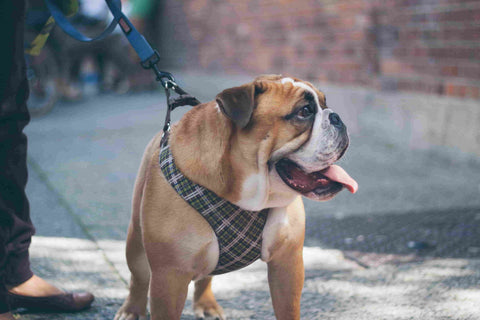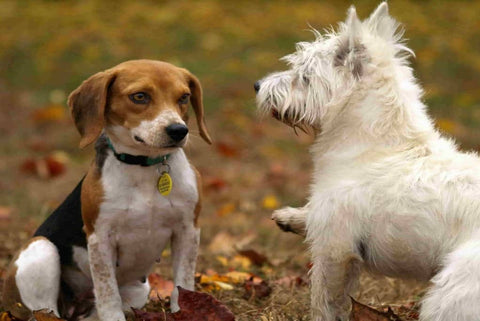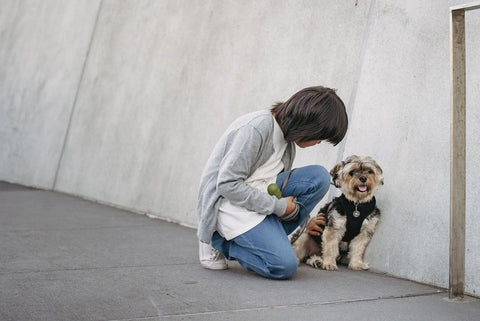How to Pick the Right Dog Harness
A dog harness is a great option in terms of safety and comfort. To maximize the use of a harness and enjoy a great experience, consider a few key features, including size and type, as well as function.
As the leaders in high-quality dog harness designs, we cover every detail you need to know to choose the right option. It’ll make for an enjoyable walking experience for you and your dog, turning them into something you can look forward to daily.
Things to Consider Before Getting a Harness
Not all harnesses are the same, and you need to choose one that is the right fit for your dog’s needs. Some of the most important things to pay attention to include:
- Safety: Your utmost priority is safety for your dog. When you choose a harness, ensure that it’s going to fit well and not be too tight or have a design that could cause choking. Safety is one of the big advantages of a harness over a traditional leash. With a harness, the pressure is distributed so that it’s not all concentrated around your dog’s throat.
- Ease-of-use: Select a harness that’s well made but also simple in its design. You should be able to easily put it on and take it off so that it doesn’t become a chore.
- Adjustability: When the belts of a harness are adjustable, it can create a perfect, comfortable fit and can also grow with your dog’s changing needs.
- Weight: A lightweight harness will make it easy for you to grab it on the go or throw it in your bag on your way out the door.
- Clip location: There are three main options with the clip location on harnesses. There’s a back clip, a front clip, and then a dual clip design, which features both. A dual clip harness is going to offer more flexibility and multi-functionality, making it the best option.
- Reflective straps: If you like to enjoy a walk early in the morning or in the evening after a long day, ensure that your leash features reflective design elements for safety.
- Material: The material used for the design of a harness should be strong but also soft and comfortable, preventing injuries and chaffing. As far as the clip material, look for a durable metal that will give you years of use.
A Step-by-Step Guide for Choosing a Harness
We’re with you every step of the way when it comes to choosing the right harness, with the following detailed guide. We break down all the things you should know to get the right product. Once you go through this guide, you’ll be confident you’re choosing what’s best for your dog and your lifestyle.
Select the Type of Harness
First, there are different types of dog harnesses. These categories are based on the overall function and clip location.
Back-Clip Dog Harness
One design option is a back-clip dog harness. This means the clip or D-ring is located at the top back, and it’s a good option for a well-trained dog. With a back-clip harness, as long as your dog doesn’t pull, he’ll be safe and comfortable.
If your dog does still pull, however, a back-clip dog harness can counteract your training. If a dog pulls and they’re clipped in at the back, they may feel discomfort.
A back-clip harness does give you an element of versatility, and there’s less likelihood of a dog getting tangled if there’s too much slack in the leash.
Some dogs also prefer a back-clip, and they’re less likely to try and chew it.
Step-In Dog Harness
Typically a harness is designed to form a rectangle at the legs, but a step-in harness offers an alternative that creates triangles at the legs.
A step-in harness lays on the ground, and then, as the name indicates, your dog can step into it, and you then fasten it.
If your dog doesn’t like being on a leash typically or struggles when you put on a traditional collar, a step-in harness may work well for you. You may find you prefer the step-in harness as well since it’s easier to use.
Front-Clip Dog Harness
A front-clip harness is ideal if you’re still training your dog. In fact, this is often what you’ll see professional dog trainers use. A front-clip harness puts a limit to how much your dog can pull on the leash. It gives you more control over your dog’s movement, and it can work as a training tool to prevent negative walking behaviors.
A front-clip harness will cause slight discomfort if there’s pulling, which is part of the training element.
Dual-Clip Dog Harness
If you want a harness that can meet your long-term needs and can be used in a variety of situations, go for a dual-clip harness.
A harness with two clips offers the benefits of both a front and back clip. You can train your dog using the front clip, or you might use it if you’re in a crowded situation requiring more control. Then, once your dog is trained or you’re in a less congested area, switch to the back clip, which is the most comfortable option.
Take the Correct Dog Measurements
A good fit is important with a dog harness. Follow these steps to make sure you get the correct size when you’re shopping:
1.) Use either a soft measuring tape, or if you don’t have one available, you can use a ruler and string. You can also use something like a ribbon or scarf along with a ruler.
2.) Measure your dog’s neck girth. You want to get a measurement of the lower neck at the widest point. A harness sits lower on the neck than a collar, which is why you want to get that base girth.
3.) Take a measurement of your dog’s chest. To do this, you should wrap your tape around the widest part of the torso. This is typically the area right behind your dog’s front legs. You might also think of it as your dog’s armpits.
4.) Get a measurement of your dog’s length, from just behind the front legs, to their back body, at the point right behind their rear leg.
5.) Compare your measurements to the Pet&Cuddle size chart. While weight might be helpful to guide your size choice, it’s not the only measurement you rely on.
6.) Choose the Pet&Cuddle harness that’s the best fit for your dog.
As a note, if your dog is on the cut-off between two sizes based on the chart, size up and then adjust it as you need to.
Additionally, once you get your harness, you can check the fit by slipping any two fingers underneath any part of the strap. The harness also should not be able to slip over your dog’s head when it’s fastened. If it can, it’s too big or needs to be readjusted.
Adjust a Harness to Your Dog
Even when you’ve selected the right size, adjustments are often needed on a new harness. Once you’ve adjusted both the harness and your leash, you’re ready to head out for a walk!
Benefits of Using a Dog Harness
If you haven’t used one before, there are significant benefits of using a dog harness compared to a typical collar. Some of these benefits can make your dog more comfortable, but they also improve safety and your overall experience when you’re on walks.
- Control: If you’ve ever felt nervous or out-of-control when you’re walking your dog, a harness is a good way to combat that. A harness gives you the peace of mind of knowing that you are the one who’s controlling your walk, and it’s not the other way around. This can be especially comforting if you’re walking in a highly trafficked area like a crowded sidewalk. Also, you may need this added sense of control if your dog isn’t fully trained on walking technique yet.
- Training: For dogs still in training, a harness is an excellent tool. A no-pull harness will teach your dog how to walk properly, and it’s much more effective than a collar and more comfortable and safe than something like a choke collar, which is not recommended.
- Comfort: The pressure points of a harness are dispersed around a dog’s body, rather than concentrating it all at their neck. It’s easier for a dog to adjust to wearing one since there is a higher comfort level.
Is It Okay to Use a Retractable Leash with a Harness?
At Pet&Cuddle, one of the most common questions we get is whether or not it’s safe to use a retractable leash with a harness, and the answer is yes! It can be a great combination, as long as you keep a few things in mind.
First, anytime you’re using a retractable leash, be mindful of your environment and your dog’s behavior. This helps you avoid tangling and any other hazards. Also, if possible, try using a back clip on the harness if you’re also using a retractable leash. This will help avoid pinching together between your dog’s shoulders.
The big takeaway is that you don’t want to use a retractable leash with a no-pull harness because otherwise, your dog is going to think they’re pulling even if they’re not. The best way to use a retractable leash with a harness is to hook it to the back clip.
If you do use a retractable leash with a front clip, then just ensure that you’re not letting it generate tension on the clip. You can avoid this by giving some slack on the leash.
Should You Really Use a Harness?
Our biggest recommendation, as experts in all-things dogs, is that you should absolutely use a harness. Once you experience the difference, if you’re used to a collar, you’ll see what we mean.
The walking experience you have with your dog will be completely different, and you’ll both be happier. You’ll notice the difference in their comfort level, you’ll feel more in control and confident, and walks will give you both something to look forward to, rather than being a struggle or a chore.
We, the Pet&Cuddle dog lovers, are constantly creating new dog harness collections, which are safe, multifunctional, and effective for training, leading, or adapting purposes.
Check out the latest dog harness collection we created exactly for your dog here.
Questions About Using Dog Harnesses
If you still have any questions about dog harnesses, we can help you. We compiled some of the most common below.
When to Start Using Harnesses for a Puppy?
If you get the right size and it fits well, dog harnesses can be used at almost any age. The general recommendation from most veterinarians is that you wait until your puppy is at least eight months old, but in your specific situation, your vet may have a different guideline. Again, the fit and the safety of the design are the biggest priorities.
Is a Harness Better than Collar?
A harness is superior to a collar in several key ways. Harnesses are more comfortable because force and pressure aren’t being put on the throat. It’s all evenly distributed around your dog’s body. This also makes it a safer option compared to a collar. The potential for injury is significantly reduced when you use a harness.
Dog harnesses give you more control when you’re walking your dog and more versatility in different situations. For example, with the added control, you can more easily navigate a crowded area with your dog.
Can a Dog Wear Harness All Day?
It’s not a good idea for a dog to wear a harness all day. It can be worn for extended periods, but if you leave it on throughout the day, it can get uncomfortable. It’s better to reserve it for certain activities. Then, when your dog sees it come out, he knows it’s time to go for a walk or play. You can start to develop a routine.
When Is It Better to Use a Harness?
Any time you’re going to walk your dog or do outside activities, the use of a harness is appropriate. If you want to train your dog, or you need a high level of control, it’s also a good option.
Get the Best Harness From Pet&Cuddle
Taking the tips above into account, it’s not only fairly simple but also fun to choose a great harness for your dog. Remember all the key features, and then find a design that you love.
We, at Pet&Cuddle, have processed all the knowledge and practical experiences to create the perfect harness with a unique design. Comfortable and safe, it now can be easily used for many purposes like training, walking, or adapting to a leash. Discover the latest products for dogs available on our website!




